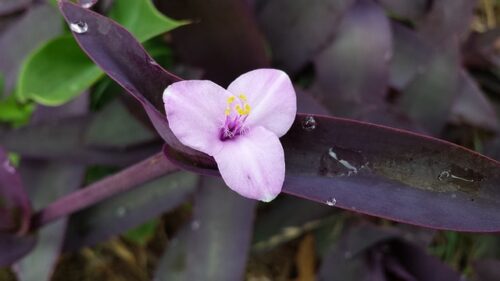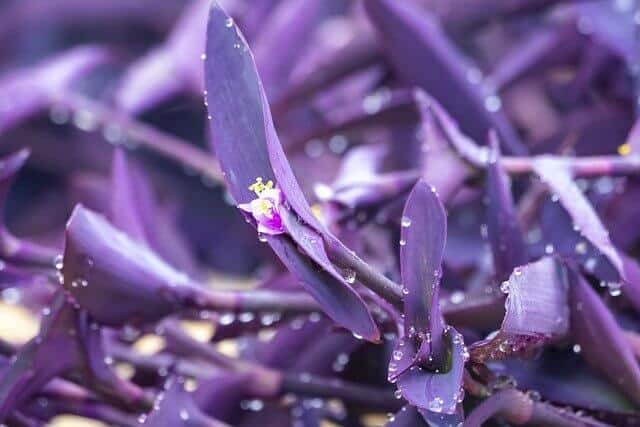Curious about the possibility of growing your Wandering Jew plant outdoors? Before exploring that, it’s worth noting that Tradescantia pallida, commonly known as the Wandering Jew, is a low-maintenance plant grown extensively in North America. Renowned for its unique zebra-like stripes, pink flowers, and purplish foliage, it thrives as a hanging plant year-round. Adaptable to various climatic conditions and requiring minimal care, this plant is an ideal choice for both indoor and outdoor settings. Hardy in zones 9, 10, and 11, it can also serve as an attractive ground cover.
The Wandering Jew plant, also known as Tradescantia pallida, holds its own story behind its name. This resilient plant can flourish in diverse environments, but caring for it differs between indoor and outdoor settings. If you’re considering outdoor cultivation, there are specific requirements to consider.
Yes, you can grow a Wandering Jew plant outdoors if you reside in USDA plant hardiness zones 9 through 11. These zones offer the warm temperatures that Wandering Jew plants favor. They typically regrow each year, but if winter temperatures drop below 60–65°F (16–18°C), it’s essential to bring them indoors to protect them from the cold.
For those aiming to achieve a bushier appearance for their Wandering Jew plants, proper pruning during the growing season is key. To promote bushiness, follow these steps: repot the plant into a larger container, provide adequate water and light, address any insect issues, and consider additional growth support through methods such as grow lights or natural remedies like neem oil.
If fortunate enough to reside in USDA plant hardiness zones 9 through 11, it’s possible to maintain Wandering Jew plants outdoors throughout the year. These regions offer the warm temperatures and conditions that these plants thrive in. It’s crucial to place the plant in an area with a consistent temperature range of 50-80°F (10-27°C) and provide the appropriate amount of sunlight for healthy growth by choosing a location with indirect sunlight to reduce the risk of damage from direct sunlight.
However, it’s important to monitor the weather closely. When winter arrives and temperatures drop below 60-65°F (16-18°C), it’s time to bring the Wandering Jew plant indoors. Prolonged exposure to cold weather can harm this tropical plant, as it is not equipped to withstand such conditions.
For those outside USDA zones 9 to 11, it is advisable to keep the Wandering Jew plant indoors. Placing it in a hanging basket or a well-draining container with sufficient sunlight and partial shade mimics its natural habitat and promotes the plant’s health. Using well-draining potting soil and placing the container in a sunny yet partly shady location indoors will contribute to the well-being of the plant.
Wandering Jew Plant Outdoors
The suitability of keeping a Wandering Jew plant outdoors hinges on providing the right conditions, notably placing them in areas with indirect sunlight. Harsh light outdoors can potentially harm these plants, making it essential to select locations that offer gentle, indirect sunlight. While Wandering Jew plants thrive in warm indoor temperatures, their outdoor counterparts have distinct requirements.
As houseplants, Wandering Jew plants exhibit rapid growth. However, when cultivated outdoors, they have the potential to become invasive, quickly covering substantial portions of gardens or landscapes. To manage this exuberant growth, regular pruning is recommended. Fortunately, this task is not arduous, as the plant’s growth is easily observable and manageable. Integrating Wandering Jew plants into your garden or hanging them from trees adds a touch of beauty to outdoor spaces.
Preferring bright indirect light, these plants are well-suited to thrive beneath trees. Their stems gracefully extend beyond container edges, cascading downward toward the ground. Utilizing Wandering Jew plants as ground cover is also a favorable option, providing an aesthetic addition to outdoor spaces. Whether obtained from a nursery, local market, or propagated from an existing plant, acquiring a Wandering Jew plant for outdoor cultivation is easily achievable.
For optimal outdoor growth, ensure the use of well-draining soil, incorporating a potting mix enriched with organic matter and perlite for effective drainage. Propagating Wandering Jew plants outdoors involves taking stem cuttings and removing the lower two inches of leaves to stimulate root development. Initial care is essential, but once established, these plants thrive with minimal support, relying primarily on adequate watering.
Growing Tradescantia zebrina outdoors presents another option, particularly as a ground cover. Observing it in walkways or alongside other trees enhances its visual appeal. Some individuals even experiment with growing it in tandem with other trees, creating a visually pleasing arrangement. When integrated into outdoor spaces, Wandering Jew plants can be strategically lined along house edges, contributing to an aesthetically pleasing landscape.
For those with wandering outdoor cats, it’s crucial to be aware of the plant’s toxicity. Understanding the potential risks associated with Wandering Jew plants ensures the safety of pets that may come into contact with them.
Buy Wandering Jew Plant Here are the links :
Did you know Wandering Jew Plant Spiritual meaning? check today!

Wandering Jew Plant Care
So You have planted The Cutting in Outside , Wandering Jew plant thrives in moist soil and doesn’t like being overwatered. They can stay underwater but not overwater as this directly impacts the roots , the heart of the plant. Even These Plants can tolerate drought climates but don’t forget to give them sufficient water.
Giving Wandering Jew 50% fertilizer needs can boost its overall growth and health of the plant. It also helps them create strong rooting. When Growing them Outdoors it is best to prune them often , as this leads to bushier growth . You can pinch some of the stems and these can again be used for propagation of wandering Jew plants. Both Soil and Water can be done.
In Winters the freezing temperature is high and plants may not survive outdoors. However, These plants can adjust in cold climates for a short time, then when spring starts they will regain strength and grow back.
If they have provided a warm , hot and minimum humidity place then definitely wandering jew will grow for years and even you can see how fast they grow in this climate.

Do you have pets?
So Do Your dog or cat run around in the garden? Did you cat go everywhere or your dog sometimes walk in the garden area or yard or any landscape. Did You live in an area where Deer came often?
If yes! Then Let me tell you why you need to know about this issue! When growing Wandering Jew Outdoors pets like cats or dogs will go someday if you are an owner who gives free play to the pets. Deer might not harm wandering Jew but they may graze on the bushes or on the fence.
According to ASPCA , Tradescantia or inch plant ( Spiderwort) can give skin irritation problems in cats and dogs , this issue is called dermatitis. You may have heard this if you are a long time gardener. I suggest if your yard or landscape have visits of any wildlife animal or your own pet goes by then rethink about planting this wandering jew or you can still grow them if you can find an area which can be out of reach from these animals.
Prevention:
Cats or Dogs generally don’t eat plants. There are cases where dogs do eat some kind of plants but there’s a reason for that , they don’t have food to eat right. So if your pets are getting meals in time they won’t eat these plants. Even they are trained to not eat this when they regularly get food.
You can also call the Animal Care center for help.
Conclusion
These plants are easy grown so Most people don’t get issues from these. Those who have pets are extra careful but they just grow them where pests can’t reach them means in hanging pots and by pruning the size of this plant is limited so no pet can reach there. I hope you get the answer on “Wandering Jew Plant Outdoors” and if you like to read more check the below articles.
Snake Plant Benefits in Bedroom – 5 Reasons(Good For Sleep)
Prayer Plant Problems – Yellow Leaves, Brown Tips(How to Fix)
